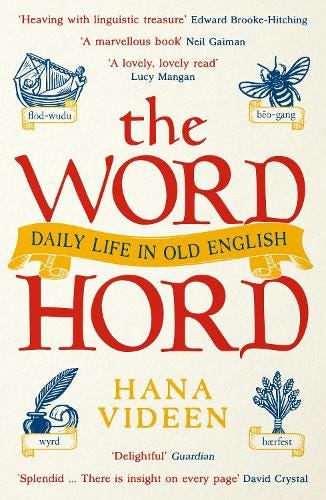
My Rating: ★★★★☆
Intro & Summary
Hana Videen’s The Wordhord: Daily Life in Old English takes on the style of a vocabulary builder with a historical bent. As the name suggests, it’s a regular hoard of words from Old English (the language of the Anglo-Saxons), many of which have survived in some form into Modern English, and just as many have not (though maybe should have).
Videen, Hana. The Wordhord: Daily Life in Old English. Croydon: Profile Books, 2021.
Readability
The Wordhord is a rather short book, for a history text, at just under 300 pages. Videen’s writing style is conversational, and each chapter follows a particular theme (“Eating and Drinking”, “Learning and Working”, etc) and ends with a vocabulary list of all the Old English words mentioned throughout in boldface. The vocabulary lists even include both phonetic and IPA pronunciation guides for each word.
All this together makes up a book that I think is both accessible to those who aren’t versed in history or linguistics but still displays some scholarly rigour and makes it a useful reference and learning tool.
The end of the book also includes a chapter-by-chapter bibliography, for those who really want to dig into the scholarly aspect. Or those who just want to read further.
Learning
This isn’t a complicated book, so there’s not much more to speak about regarding what I learned from it that I haven’t already mentioned.
I do want to reiterate, though, how much I like the vocabulary lists (the wordhords) at the end of each chapter and that each word that goes into that wordhord shows up in boldface in the text. I found myself flipping forward to the lists to check pronunciation and definition quite often as I progressed through the book.
From the linguistic angle, Videen also talks often about how Old English progressed to Middle and Modern English; sometimes with cultural changes, other times through full changes of language, such as the injection of French after the Norman invasion in 1066.
And finally, this book does one of my favourite things any history-type book can (especially those made accessible for the general public). It provides interesting hooks into other topics and historical figures for those interested to go learn more about.
Have you read Beowulf? Do you know who the Venerable Bede was or anything about his Ecclesiastical History of the English People? They’re mentioned here within the context of the words and topics Videen discusses, but if you want to know more you’ll have to go look them up yourself. And that’s just a couple examples.
On a personal note, having already read Basilisks and Beowulf provided some additional insight into some of the linguistic and cultural topics that appeared in this book.
Would I Read It Again?
Absolutely.
This book has earned a permanent place on my shelf as both a historical text and as a book that’s just plain enjoyable to read.
Videen’s next book, The Deorhord: An Old English Bestiary, comes out in paperback in November. Between that and The Hogfather, my winter holiday reading list is already set!


